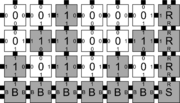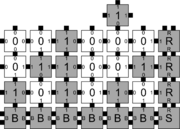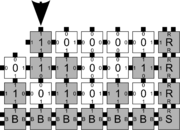Difference between revisions of "Facet Errors"
Jump to navigation
Jump to search
| (One intermediate revision by one other user not shown) | |||
| Line 1: | Line 1: | ||
| − | In the [[Kinetic Tile Assembly Model | kTAM]], a facet error occurs on the edge of a growing assembly. Furthermore, this error occurs when a tile binds with insufficient strength for permanent attachment (but with no mismatches), and is locked into place by a subsequent tile addition (see figures below for an example). | + | In the [[Kinetic Tile Assembly Model (kTAM) | kTAM]], a facet error occurs on the edge of a growing assembly. Furthermore, this error occurs when a tile binds with insufficient strength for permanent attachment (but with no mismatches), and is locked into place by a subsequent tile addition (see figures below for an example). |
{{multiple image | {{multiple image | ||
| Line 22: | Line 22: | ||
[[Category:Terminology]] | [[Category:Terminology]] | ||
| + | [[Category:Self-assembly]] | ||
Latest revision as of 15:19, 27 May 2014
In the kTAM, a facet error occurs on the edge of a growing assembly. Furthermore, this error occurs when a tile binds with insufficient strength for permanent attachment (but with no mismatches), and is locked into place by a subsequent tile addition (see figures below for an example).


